New sets ask you to try something different and branch out from your comfortable favorites. The Seeking Horizons series aims to bridge those gaps and make connections between what you enjoy doing now and what you may enjoy with the next set's debut.
Today, we consider Kayo and revisit Rhinar.
The game design of Flesh and Blood is defined by class card pools. The distinct playstyles, strengths, and weaknesses of heroes are largely established by the cards that they uniquely have access to. Generics, while prominent in the overall meta, comprise a small portion of any given deck; you are heavily incentivized to use the cards that make your hero distinct.
At the same time, Flesh and Blood expansions are traditionally focused on a small subset of the classes in the game - which means that, if you've found yourself committed to, say, an Illusionist, you may look at the upcoming release of Heavy Hitters and ask, "What's in it for me?" The expansion slot - which debuted in Bright Lights and continues here - offers direct (albeit limited) support for most every hero and class through its off-theme inclusions. But that leaves the bulk of the set outside your interests.
I'd like to argue for why it's worth expanding your horizons, and we'll start that today with a focus on the Brutes: what they offer, why you might be surprised to find you enjoy them, and why it's worth playing them even if you never intend to main one.
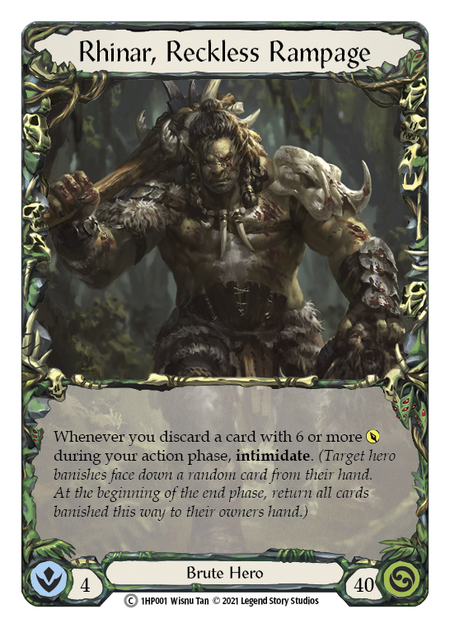
Defining the Class
If you've never played Rhinar, you may get a lot out of our FAB101 primer on Rhinar and the Brute Class.
Brute was a day 1 class, and as a result its core gameplay is fairly straightforward: Brutes discard cards in exchange for greater power in their attacks. Initially, those discards took the form of additional costs; but as time has passed and the class has evolved, discard effects have also come in other forms. Rhinar has carried the banner for Brutes all this time, and so the reward for an optimal discard of a 6+ power attack has primarily been removing defensive options via intimidate.
Intimidate: Target hero banishes face down a random card from their hand. At the beginning of the end phase, return all cards banished this way to their owners hand.
Due to these dynamics, Brutes are often seen as preferring a 3-card hand: one card to play, one card to pitch, and one card to discard. In order to ensure an optimal turn and control for the 'random discard', that 4th card is often used to block. The floor of a Brute turn is 6 damage and a steady grind toward mutual fatigue, but the ceiling can be much higher.
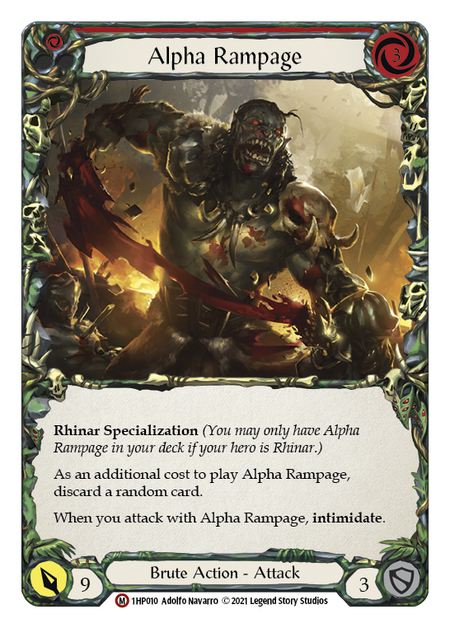

Because of the underlying numerical rules of FAB's game design, Brute cards tend not to both pitch for 3 and deal 6 damage - and herein lies one of the limitations of the class. Brutes require blue cards to pay for their best attacks, but drawing too many in one hand can threaten the consistency of intimidate triggers. Without intimidate, Rhinar's attacks simply aren't disruptive in a meaningful way.
Taken together, the picture of the Brute archetype looks something like this: consistent threat of 6+ turn after turn, able to block out, able to go to fatigue, occasionally overwhelming turn cycles - but ultimately reliant on luck to win.
Note: We've focused on Rhinar, but there are two other Brutes we should mention. Kayo, Berserker Runt is a fun Blitz hero who may lean a little too far into RNG. And Levia, Shadowborn Abomination trades 'discard' for 'banish' while maintaining the same focus on 6+ power cards. Because this article intends to bridge into Heavy Hitters, we'll leave the Shadow variant of Brute out of the conversation; and while the Runt is a terror with the right dice, he's ultimately done little to change the identity of the class. Rhinar remains the standard.
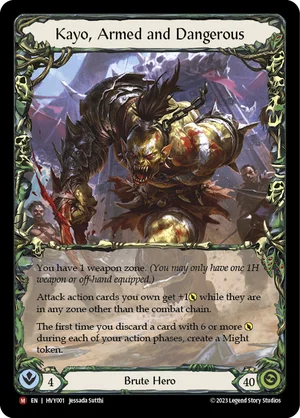
The Influence of Heavy Hitters
Whenever a class received a focus slot in a new expansion, you can bet they'll also see new variations on the same strategies. While we're still a long ways out from a full set list, with Heavy Hitters, we've begun to see that take form in a few changes.
The most significant, of course, is the new Kayo, Armed and Dangerous. This fresh variant of Blitz' Berserker is notable for refreshing countless pitch cycles in the established card pool: the 5-power Brute attacks that, to this point, had served only as draft chaff.
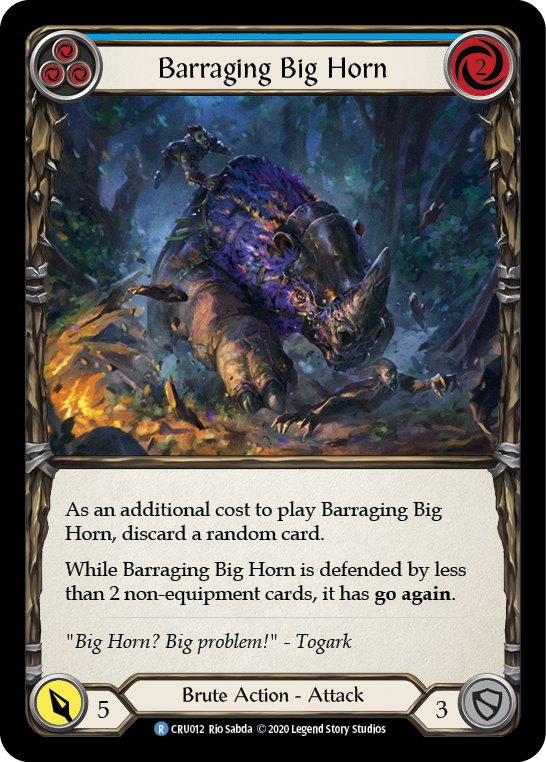
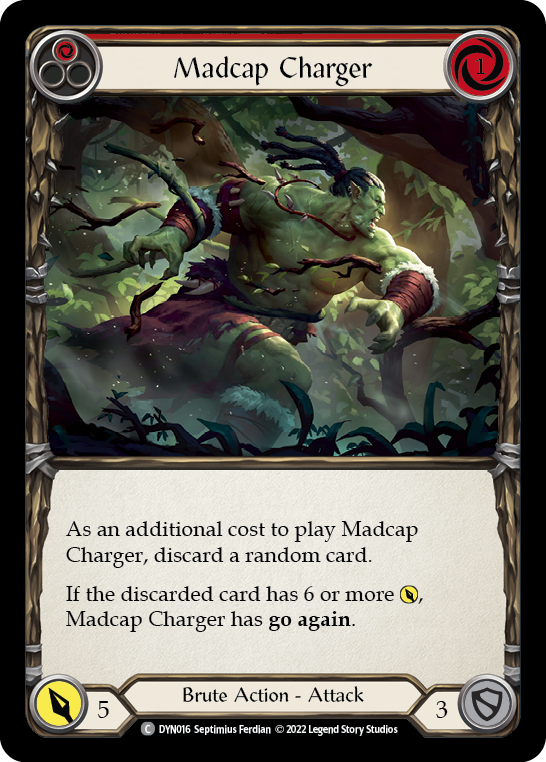
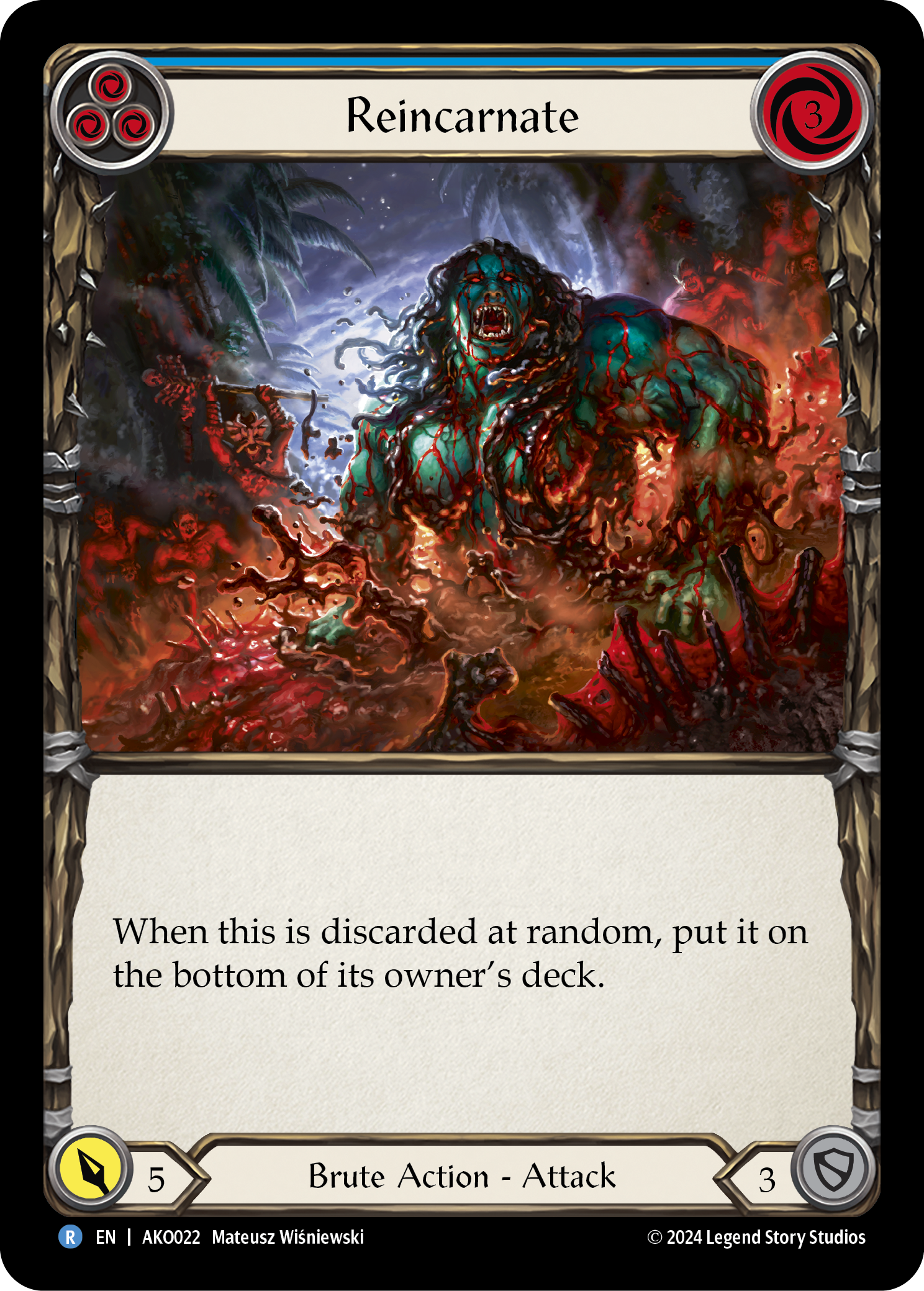
This provides a massive infusion of blue cards that also meet the standard of 6+ power when discarded - a benchmark that many Brute card effects are looking for. And while these cards won't be any stronger while attacking, Kayo will reward you for discarding correctly by conjuring a Might token for your next turn.
Might tokens are one of two that we've seen prominently featured for Brutes - with the other being Agility, a new option for gaining go again at the start of your next turn. Brutes have traditionally struggled to make use of 4-card hands when they see them, or to consistently follow up a big attack with a weapon swing. Improved access to Agility tokens should give the class new options for pivoting away from defense when it's not needed.
We've also seen the recurrence of a new mechanic called clash. This compares the power of the top card of each player's deck, and rewards the higher powered reveal. With a deck full of 6+ power, Brutes should be relatively consistent with winning these clashes - while incidentally gaining some information on the opponent's next hand.
Finally, Brute cards look to be adding a new method for discarding cards: simply choosing to do so. Beat chest is a new keyword that gives you the choice to discard a 6+ power card as an additional cost, rather than requiring it. We've also seen attacks simply reading, "Instant - Discard this", with some form of compensation for doing so. These stand to revolutionize the RNG that was previously inherent to the class, should you choose to sidestep it.
Overall, the picture being painted for Brute in the early days of Heavy Hitters previews is a less chaotic class that's better at pivoting from defensive to offensive. And while we've still got the same old Rhinar at the helm, the new option of Kayo truly diversifies the deckbuilding options with distinct flavors that should appeal to different players.

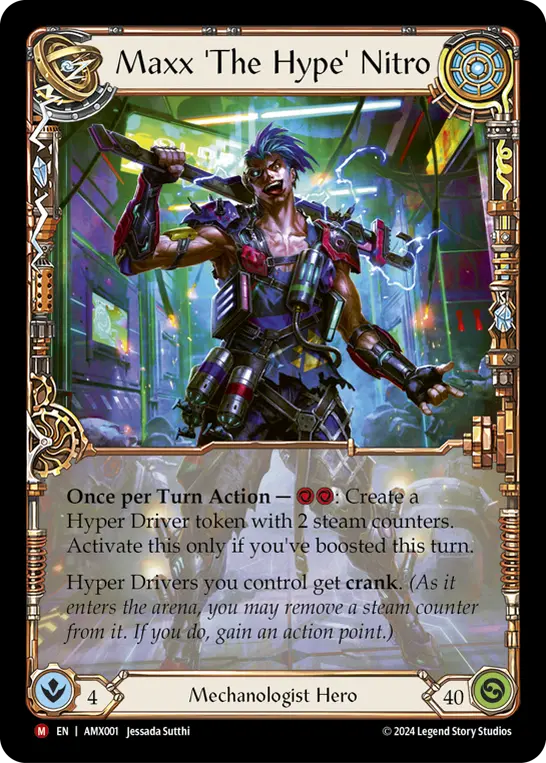

Comparable Champions
We often talk about the similarities between heroes and classes when Living Legend claims another champion, but it's worth evaluating with a new set's release as well. For many of us, Heavy Hitters isn't directly enhancing our favorite builds - but it may be providing novel ways to play our favorite strategies. And in the case of Brutes, there's so much more than meets the eye.

Comparisons to Guardians come naturally. Both Rhinar and Bravo appeared in Welcome to Rathe, and often competed for the same generics during drafts. Both classes boast reliable 3s in the lower right corner, allowing you the freedom to block with your attack phase in mind; and both classes can confidently fall back on hard-hitting weapons, making them well suited for late-game wins as the enemy fatigues. (This is less true of Kayo, who can't equip 2-handed weapons.)
The distinction between them is twofold. Guardians have an enhanced defensive posture thanks to dedicated defensive cards and dense equipment. And while both classes often require 2 cards to pay for their attacks, Guardians pitch both of them, preserving their deck longer. (There's a 3rd variable of 'on-hit effects' in Guardian, but that's seldom the focal point of a Guardian's build.)
For Guardian players, sidestepping into Brute should feel quite comfortable. And as Guardians are also featured in Heavy Hitters, you should be coming into these new Brute tools organically.
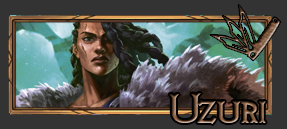
The correlation between Brute and Assassin may not come as rapidly, but walk with me a moment. Assassins - and Uzuri in particular - are excellent at responding to the opponent and choosing their moment to strike. They shift between offensive and defensive turns without difficulty, and benefit from the growing effects of fatigue without specifically playing for it.
You can build a Brute similarly - and I think it will prove to be a successful strategy for Kayo in particular, due to his use of tokens. By using cards that generate discard effects outside of the 3-card hand, you can opt for a defensive tack while tucking away tokens (at minimum, Kayo's Might token) to improve your next turn.
While Brutes aren't known for Reactions, Kayo will have access to a suite of varied attack patterns, which is something Uzuri is known for. Your turn can consist of a single big attack, a one-two from hand with the help of Agility, or conclude with a weapon swing that breaks up the damage across multiple attacks.
If you've found joy in wearing out your opponent across an aggressive game, there's a Brute build that will speak to the tireless Assassin in you.
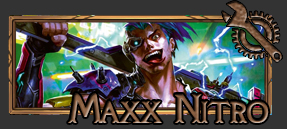
Maxx is unique among rushdown heroes for his ability to play resource-intensive cards across a wide chain of attacks. But with Kayo in the mix, we can now consider a wider approach, narrowing the gap between Brute and Mechanologist.
Thanks to Kayo's passive +1 to cards not on the combat chain, we're adding at least 18 blue Brute 6s to the card pool. But in doing so, we risk drawing more blue-skewed hands. That encourages Kayo to pay for more things - like a Mandible Claw swing or a second attack - to make use of both a larger grip of cards and a deeper pool of resources.
Like Mechs, Brutes are prepared to burn cards along the way. And like Mechs, what we get to show for it is largely pushed damage numbers. When the threat we present is 'just numbers', it's essential that those numbers add up before our deck runs out. This drives the game forward with madcap momentum, and gives both Maxx and this theoretical Kayo a similar style.
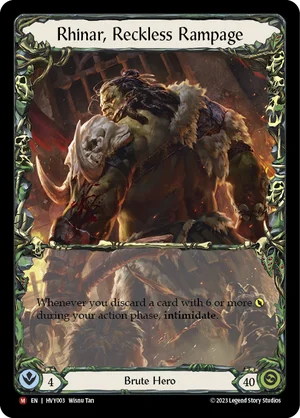
Savage Land Reconnaissance
If the Brute playstyle is completely dissimilar to your own, playing as a Brute in casual settings and your local Armory can be of great benefit to you. Playing more decks will make you better at playing FAB, period. But playing Brute, in particular, will help you in the following ways.
Brutes use their cards in multiple ways, teaching you how to effectively analyze the roles available to each card in your hand. If you're a Fai player, or if you've spent a lot of time with the original Prism, these skills may be under-developed, as best uses are often obvious as part of the class design of Draconic Ninja and Light Illusionist.
Brutes have a unique relationship with RNG. From the outside looking in, a Brute's gameplay can feel incredibly random; but from the Brute's side of the table, risks are calculated and often even controlled for entirely. Azalea mains can learn a lot from Brutes on how to play your odds and build for any outcome.
If you've played any quantity of Blitz Armories, you've probably been bodied by a Brute at some point. These early-game wins can feel completely broken; but when you're in the driver's seat, you'll see how seldom it all comes together, and the work that goes into some of their biggest turns. You'll also learn what disrupts it - a priceless tool for your next match against one.
Explore Your Brutish Nature with Heavy Hitters
Whatever your angle, there's reason to take an interest in the new Brute content in Heavy Hitters. But don't stop there! Next time, we'll take a look at what's in store for Warrior - and why you might want to make some space in your deckbox for Kassai and Olympia.


